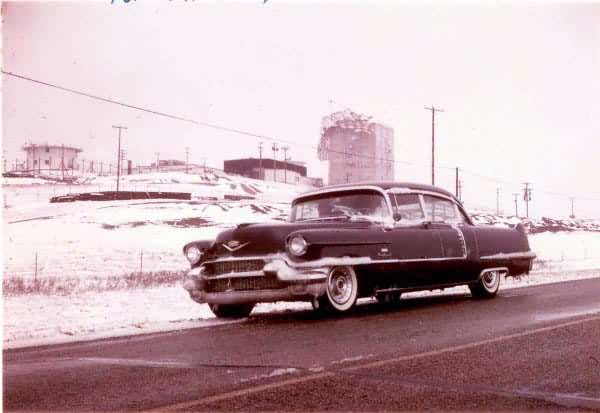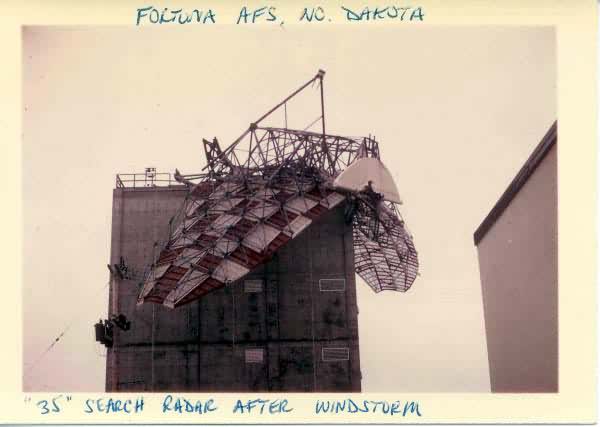780th Radar Squadron
Fortuna AFS, ND
AN/FPS-35 Antenna Collapse
Photos by Bob Caggiano


Notes contributed by Jonathan Smith
Photos by Bob Caggiano


Notes contributed by Jonathan Smith
I was stationed at Fortuna in 76 and the antenna was my primary responsibility. I talked to the CMsgt in charge of the radar who was there when it happened. He tells me that it was caused by a shear pin failure. The rear of the antenna frame comes together in the rear from top and bottom with a round interlocking connection. A large shear pin holds the two pieces together think of a door hinge and the pin. Anyway there are two end caps with large bolts to hold it together and for some reason they were not safety wired, nor were they a PM item at the time. The bolts worked loose and the pin worked out enough to shear off due to the prevailing winds which is why if you look at the picture it was kiltered to one side. They used pieces of the old antenna ribbing as parking curbs all over the site.
He also had a unique bearing that had been proposed under the program whereby a service member could get money from cost saving ideas. This math whiz proved on paper that a hollow bearing would support the same weight but last longer because the increased surface area would reduce heat. They tested the bearing under load and approved it. The 780th was due for a bearing replacement so they were the test bed. They lifted the antenna, cleared out all the old bearings and gunk and placed the new bearings with moly grease in the race. Buttoned everything back up. When they fired up the antenna the shear force crushed almost every one of the bearings! I hear it was quite the mess!
Also the SIF antenna did in fact spear the Oldsmobile point first like a javelin. A Tech Sergeant Calvin Hornback showed me a picture of it it happened not 10 minutes after hed gotten out of the car. One lucky dude.
Some additional notes by Jon:
PS: An interesting sidenote - the bull gear was lubricated with a high pressure oil injection system. The oil used was Houghton 1133A and it made molasses on a January morning look positively runny. We had to start filling a gallon jug days before it was to be used. Anyway it was mixed with high pressure/high temperature air and sprayed at each pinion gear/bullgear junction. There was a drainage tray under which theory said the cooled oil would drain into. In reality that danged oil vapor coated everything. We used gallons upon gallons of TriChlorEthane (the bad stuff) to degrease the inside of the turret every Saturday. We were one of the few AF members to have a special clothing allowance because the trike ate everything up. Later they switched to Trichlorethylene 1-2-3 inhibited.
Anyway we had a standing order at the Minot supply for 2 cases of kotex monthly. We laid the pads over everything to try and soak some of the nasty up to minimize the use of trike.
One day one of the supply folks asked what it was for and the airman told them without thinking ahead. From that point forward we had the only radar in the AF inventory officially `on the rag`.
Another story The motors were ramped up to speed via relay switching in the "Reliance cabinet". It switched the motor stator windings from a delta to Y configuration much like changing gears. Delta windings provided a high torque low RPM and Y was high RPM nominal torque. One day the master relay stuck in the final configuration. We hit start and damn near screwed the tower into the ground it felt like an earthquake. The power plant called up screaming we had tripped their overloads and shut them down over 10 megawatts.
We popped all three power fuses coming in 50,000 amps.
Building inspection revealed about a half dozen cracks in the building walls.
email notes from Tom Page
When I was at HQ 21st Air Division, Hancock Field, NY, between 1981 and 1983, one of the NCO`s in QC told me about an ADC IG inspection at the Air Division headquarters that Fortuna AFS reported to probably the Minot AFB SAGE DC back then. According to the story, one of the IG inspectors was in Job Control when a call came in from Fortuna AFS, saying "the AN/FPS-35 antenna is down." The Job Controller logged the information, opened a maintenance ticket, thanked the caller, and hung up. When the Job Controller posted the information on the Air Division status board, the IG inspector reportedly looked up, then asked, "What do you mean, the antenna is down?!" The Job Controller, quiet for a moment, replied, "I don`t know. He only said that the antenna was down." So the IG inspector said, "Well, call him back, and find out what the hell is going on!" The Job Controller called the Fortuna AFS AN/FPS-35 work center back, and asked,"What do you mean, the AN/FPS-35 antenna is down?" Apparently, there was some awkward silence, then came the reply, "Er, uhm, our antenna is, uhm, down. A windstorm knocked it off the tower." At that point, according to the story, all hell broke loose. The Job Controller got into all kinds of trouble for not asking the right questions.
Also, further investigation, allegedly, revealed that the Fortuna AN/FPS-35 crew had not put the antenna into "safe mode" (free-wheel) when the wind-speed indicator reached the critical limit.
Reportedly, a mobile search radar (I`m don`t know what kind) had to be brought in and operated until the AN/FPS-35 sail could be repaired. Again, I don`t know if the events occurred as I was told (or as I remember), but I now know the antenna did get blown over.
-- TomAdditional note from Eugene Culp
I was assigned to the unit from Nov 63 through Nov 64 as a Weapons Controller. The squadron call sign at that time was Mutely. (I was assigned the call sign Mutely 07.) I was there when the FPS-35 antenna fell over the side of the tower. As I recall, the main antenna draped over the side of the tower but the SIF antenna fell to the ground and wiped out the Oldsmobile belonging to the NCOIC of Radar Maintenance (A CMSgt whose name I`ve forgotten).
I was one of only three WC`s who were Operationally Ready and to maintain our currency we were flown to Havre AFS MT each quarter to control the required number of intercepts.
More info from Gene Culp:
I`ve examined the picture of the FPS-35 antenna before the accident and have
identified the antenna which damaged the CMS` car. I recall it being named
the "Omni antenna" and it is the pencil like antenna which sits above the
SIF antenna. It is clearly visible in the photograph and its shape and size
fit what I remember seeing laying across the car.
I noted in the comments about the accident that the commander was fired over
the incident. Not so.
[Ed. note - comment removed - Gene]
The commander was Major Phillip J. Acton and, as a reserve officer, he reached his mandatory 20 years` service while at Fortuna and retired for length of service completely independent of the antenna incident. The squadron radar maintenance officer, Glenn E. Mays, a Captain at the time, went on to become a Colonel so he wasn`t hurt careerwise by the incident. In fact, I asked him at the time if he was going to be the "fall guy" for the incident and he replied he had previously identified the problem (the anchor keypin holding the antenna arms in place worked loose from its fitting) and had applied the modification HQ ADC and the tech rep recommended. So, when the pin cut through the restraining straps (the modification) and worked completely out causing the antenna to fall, he simply showed the investigators the message traffic between Fortuna and H.Q. ADC about the previous occasion the pin had started to work loose and that was the end of his taking the blame for the incident. Incidentally, I was on the roof some time before the pin worked loose and saw the size of the pin- about three or four feet in length and about a foot in diameter as I remember it. Glenn said the maintenance troops had to pound it back in (the first time) with a sledge hammer. After it worked loose and was laying on the roof, it took three men to lift just the pin.
After the FPS-35 antenna fell over, the site was without radar for most of 1964. However, work was started on the installation of an FPS-66 on the vacant tower which can be seen in some of the photographs displayed on the site page. It was, I recall, the platform for the search radar which the FPS-35 replaced. Anyway, the FPS-66 was installed but not fully tested by the time the 24th AD had its ORI in October of 1964. The Division commander decided to declare it operationally ready so that Fortuna could participate. During the ORI, I was assigned a pair of F-101B interceptors from Grand Forks AFB. When I made radio contact with the lead pilot, I found that the radar was "out of phase" and the fighters appeared to the west of our site when they were in fact east of Fortuna. The fighters decided I was a "spoofer" who was trying to test their reaction to bad information from GCI and left my frequency. Needless to say, our "not ready for prime time" radar picture drew a negative comment in the ORI report. I left PCS in November, 1964 and the FPS-66 was still not fully O/R.